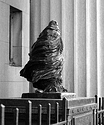Keep thinking of printing as a learning experience. I've been at it for a bit more than 15 years actively, and every time I go in the darkroom I feel a little bit like a beginner. It's healthy to keep an open mind, and also to realize that the first couple of thousand prints will probably not be awesome. Just keep doing it, and eventually you'll start feeling like you're printing the way you want your prints to look.
The whole b&w printing is a system, where all of the decisions you made until you spot your prints are distilled onto the paper. It's a representation of all those steps. You can make it easy for yourself and work with one paper and one film until you get really great prints from those materials. Limit the use of different developers too. There ARE differences between various materials, sometimes pretty stark too, but you will not learn to fully exploit it unless you have really solid technique and a solid understanding of the b&w printing system. The word system is important.
Anyway, keep on keeping on. Make sure you have a good time. Be observant. Enjoy the ride.







